Six Wives
 By Charlotte Fern
By Charlotte Fern
Catherine of
were very distinct and individual women in their own right and were much more than just one of six. They faced more grief and trouble in their lives because of Henry and were not the women he left them to be illustrated as. They were more than promiscuous or ugly or a sole caregiver. They were advocates for equality, inspired development and evolution, and were responsible for revolutionary changes in England and it’s Church.
Catherine of Aragon: the first wife of Henry VIII yet not her first husband. She was engaged and to marry Henry’s brother, Arthur, when she was just three and he was two and then at sixteen, Catherine set sail to England and married. Arthur died six months later but the English king wanted to keep the dowry and the loyalty of the Spanish royal family as they were extremely powerful figures at the time. His solution was for her to marry Henry and she soon began a long road of traumatic miscarriages and still-births in a bid to give Henry an heir to the throne. In 1516, they finally had a surviving child, Mary, but she wasn’t the male heir Henry wanted. Henry was involved with at least two of Catherine’s ladies in waiting during Mary’s childhood and eventually fell in love with Anne Boleyn. Catherine was an early advocate for women’s right to an education. She was given a comprehensive education, speaking many languages by the time she married Prince Arthur and so she was determined to afford the same privilege to her own daughter, Mary. In 1523, Catherine commissioned a book entitled ‘The Education of a Christian Woman’, in which she advocated education for all women, regardless of social class or ability. After fighting for six years against the file for divorce (in hope of protecting her daughter’s status and position) she was cast out and exiled, yet she refused to acknowledge her status as ‘princess’ claiming she was and will always be a queen and her loyalty to Henry never wavered. She died three years later, leaving Henry free to move on to Anne Boleyn. Although she’s seen as the catalyst for the breakdown of Henry’s first marriage, Anne Boleyn in fact refused his advances initially with no interest in becoming a mistress and Henry only knew of Anne as he’d already had an affair with her sister, Mary. Once divorced, Henry and Anne married and she soon gave birth to Elizabeth but with no other children, Henry quickly lost interest. Anne reacted very differently to Henry’s sexual escapades compared to Catherine and reportedly was enraged by his infidelity and plotted to get rid of his unnamed mistress. Desperate to get rid of Anne, Henry accused her of adultery and treason and had the marriage annulled.
Anne was beheaded two days later for her crimes and yet it is believed by many historians that Henry fabricated the charges against his second ex-wife.
 Aragon, Anne Boleyn, Jane Seymour, Anne of Cleves, Katherine Howard and Catherine Parr
Aragon, Anne Boleyn, Jane Seymour, Anne of Cleves, Katherine Howard and Catherine Parr
Just days after Anne’s execution, Henry married Jane Seymour who had in fact been a lady in waiting for both of the previous wives. Reportedly, Jane and Anne shared the same grandmother and so were raised together for a period and so Anne knew when Henry became interested in Jane later in their lives. Apparently the two women went into conflict with one another on more than one occasion. Jane died following complications with childbirth after having Edward VI in 1537 and is thought by some to be the only wife Henry truly loved. Edward suffered poor health and died at 12 years old after three years on the throne.
Henry did remain single for two years before being advised to create a European alliance by marrying one of the sisters of Germany’s Duke of Cleves. Henry thought Anne looked like the prettier one of the two after looking at their portraits but was shocked upon her arrival. Claiming she looked nothing like her portrait, he tried to halt the wedding. In reality, she had a slightly fuller figure which Henry took to mean she must not be a virgin as this was a common association during the Tudor period, but he was forced to marry her anyway. After six months, Anne of Cleves accepted a divorce and a generous settlement then proceeded to live a peaceful life but does now face the common label as the ‘ugly wife’ when recalling her time with Henry.
Katherine Howard is a little more complicated as in history, she has been written as the promiscuous wife with rumors of infidelity less than a year into her marriage. She was executed for her crimes after less than two years of marriage but there’s more to her story. Archbishop Thomas Cramner set out intentionally to find any evidence he could to show that she was unfit to be Henry’s wife. This involved bringing to light her sexual history in great detail and how her supposed lovers behaved with her, ignoring the fact she was likely in her early teens. More recent research has revealed that none of this was her choice: she was brought up in her step-grandmother’s household (the Dowager Duchess of Northumberland) with other young ladies and they shared a bedroom called the ‘maidens chamber’ supposedly safely locked at night but predatory men in the Duchess’s service had the key and took advantage of the girls. A servant named Francis Dereham even admitted to seducing Katherine but instead she was labelled as promiscuous for generations, and it gave Henry the reason he needed to execute her.
Catherine Parr is of course the wife to outlive Henry and had been illustrated as a caring nurse for her husband during his old age however Henry’s all-male medical team says otherwise. She was actually forced to leave her true love and marry Henry instead. She proceeded anyway to share her passion for learning with her very intelligent stepdaughter, Elizabeth. Catherine was the first woman to publish a book and was a very well-educated woman herself. She served as a good role model for all of Henry’s children and persuaded Henry to re-instate the girls’ positions in the line of succession. She eventually married her love after Henry died but he too turned out to be manipulative and power-driven and only took advantage of Catherine’s position and knowledge.
There was no direct happy ending for any of Henry’s queens, but their truth deserves to be known after their names have been tarnished for generations. They will forever be the six wives of Henry VIII but that also means they will forever be queens.
Was Alexander the Great actually that great?
 By Anna McGlen
By Anna McGlen
Alexander the Great was a powerful and influential leader of the ancient world. This can be shown through his successful conquests during 336-323 BC. Even though there is extensive evidence to suggest that Alexander was “Great” in relation to his military strength, is it completely accurate to describe him as “Great” in every aspect of his life? This essay will explore whether it is correct to describe the Macedonian ruler as “Great”.

Alexander the Great provides an excellent example of a strong and powerful ruler who was able to conquer a large proportion of the world, forming a dominant empire. As a young leader, he was able to conquer countries such as Persia, Anatolia, Syria, Phoenicia, Judea, Gaza and Egypt. This is significant as it shows the true extent of Alexander’s abilities, both as leader and as a war hero. However, looking at this evidence, I am not fooled by the power and dominance displaced by Alexander the “Great”, as Alexander was ruthless man, always thirsty for power. He killed hundreds of thousands of people, revealing his dangerous and potentially uncontrollable tendencies. This gives way to a more significant question as to whether such brutality and destruction has been glorified throughout history. Are we calling Alexander “Great” due to his violent displays on the battlefield, or are we valuing his aggressive nature as a form of strength and power?
Another reason why Alexander the Great lived up to his name was the cultural implications that his conquests had. Alexander’s influence remains strong to the day as he was able to join the western and eastern world through his empire and shared Greek traditions and culture with the rest of the world. This is significant as it shows the shear amount of dominance that Alexander was able to deploy. The ability to spread culture would have been hard to achieve, however, as this culture remains an influential part of modern society, it creates the impression that Alexanders’ legacy lives on, showing why he would deserve to be immortalised as “Great”.
Nevertheless, it is important to acknowledge that society has developed over time, and even though Alexander had a deep influence on how an ancient society functioned, we should explore how Alexander was not the “Great” hero he has praised of being, but rather he was quite exploitative. Alexander was born and raised in an area that thrived off slave trade. Being the King, he would have owned many slaves, and he would have spent most of his life reliant upon them. Of course, I understand that slavery was a large part of life during this period, and the whole idea of ownership was normalised in this culture. However, by immortalising him as “Great” we are almost excusing everything that he did. I believe it is important to pick apart his life and analyse the effect that his actions had on the empire that he created, the empire which has made him the international historical figure that he is today. History has been morphed into creating an idyllic character who should be remembered for all of time. But are we remembering Alexander the “Great” for all the wrong reasons?
In conclusion, the view that Alexander the Great was in fact ‘great’ is not a compelling argument. This is because Alexander the “Great” was a repressive and dangerous man with violent tendencies. Despite this, it is important to note that throughout history he has been glorified due to the large impact he had on society and how powerful he was on the battlefield. Nevertheless, it is important that historians understand the oppression and social issues that he caused.
A brief history of the corset
 By Alyssa Price
By Alyssa Price
Though there is some evidence to suggest corset style garments existed before the 16th century, appearing on such things as a Minoan figure made in around 1600 BCE, the corset as you and I know it mainly emerged into popularity in the 16th and 17th centuries.

For most of the sixteenth and seventeenth centuries corsets were known as ‘bodies’ or ‘stays’ and were worn as structural undergarments. They were worn in an effort to flatten the stomach and emphasize the fullness of the skirts of the period. The shape of a corset is achieved through stiffening fabric with starch and by the end of the 16th century, we see an introduction to lining it with a strong material (most commonly whale bone) to enhance the shape through added structure. The front of the corset was usually covered by a ‘stomacher’ typically decorative and in a V-shape to conceal the corset front.
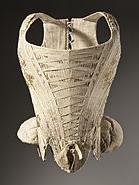

The most common type of corset in the 1700s was often worn to slim the waist, emphasize the chest and improve posture. The primary purpose of 18th-century ‘stays’ was to raise and shape the breasts as well as support the back to help a woman stand straight, with the shoulders down and back and only slightly narrow the waist. This created a "V" shaped torso over which the outer garment would be worn.





At the end of the century, the ‘empire waist’ style encouraged the popularity of ‘short stays’. These ‘short stays’ would not extend far below the bust to accentuate the regency style high waistline. This style did not last tremendously long and the 1700s saw an inverted conical shape to the corset to contrast with the full skirts below. In the 18th century the primary purpose of ‘stays’ was to raise and shape the bust, tighten the waist area and improve posture with a slightly changing silhouette creating a v shaped torso.
By 1830 a new style of corset had emerged. The 1830s were an important time for corsetry as it was now that the term “corset” was used more regularly. Transitioning into a Victorian era we see a change in material and by the 1830s, steel stays had begun to replace the whale bone.
In the late 19th century, we see the emergence of the misconception that corsets were horribly uncomfortable and “evil”. Dress reformists and some men perpetuated the ideal that they were a detriment to women's health and were dangerous to wear claiming women were fainting left, right and centre and that people were removing ribs to get a tiny waistline.
However, support for the corset didn’t dwindle and at the turn of the century we see the emergence of the Edwardian corset fashioning a new style and general figure with the s-bend becoming prominent. Post Edwardian era, the standard was a narrow-hipped, arrow-waisted silhouette which meant that corsets became longer, making the waist appear higher and wider, leading to the so called “long-line corset”.
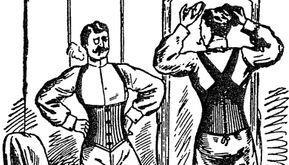
In 1914 WW1 broke out and during the war women were asked to stop buying corsets so materials such a metal could be used to aid the war effort. The corset fell from fashion after the war, and in the 1920’s we start to see the emergence of other undergarments such as the girdle and brassiere. In the 40s and 50s, there was a brief revival of corset style waist cinches to create the then desired “new look” associated with Dior but this was gone by the 60s as protestors symbolically disposed of the corset as an instrument of female torture from the patriarchy. The corset did make a comeback in the 80s goth seen, and it had become an item of outerwear remaining as such throughout the 90s and 2000s. The corset still remains today as an item of outerwear in many different style aesthetic. It should also be dually noted that at many different points in history men have worn corsets.

Who shot JFK?
By Olivia Gargan
This question remains unsolved to this day. John F Kennedy, the 35th president of the United States, was visiting Dallas Texas on 22nd November 1963, to gain support for his upcoming election campaign. He, along with his wife Jackie Kennedy, Governor Connelly and his wife Nellie Connelly, travelled in an open top car, as a part of a presidential motorcade driven by two Secret Service agents. As the car approached Dealy Plaza and turned into Elm Street, the president was shot and killed. The official line from the US government states that the president was assassinated by Lee Harvey Oswald, a former US marine. However, there are many conspiracy theories regarding who shot JFK.
The official government version of events supports the lone gunman theory which claims that Oswald singlehandedly shot the president from the sixth floor of the Texas Schoolbook Depository building. Oswald had lived in Russia (a communist country) for a short period of time before returning to the USA with a Russian wife and child. At this time, Russia was amid the Cold War with the USA, on the verge of a nuclear war. Oswald, being a communist, disliked the capitalism of the USA, and the work JFK did in countering communism. Additionally, Oswald worked in the Texas Schoolbook Depository where the shots were supposedly fired from, while being the only employee missing that day. The gun that fired the shots was found there, along with another gun surrounded by cardboard boxes and a clear shooting setup. Both guns were traced back to Oswald under a false name, who had previously learnt how to use a gun during his time in the military.



However, there are many issues with the lone gunman theory. Firstly, many witnesses heard shots coming from the grassy knoll while Oswald was allegedly firing from the Schoolbook Depository. Secondly, the lone gunman theory would only be plausible if the magic bullet theory is viable, which it is not. It claims that the ‘magic bullet’ was the second shot from the gun that killed the president, that it went through Kennedy’s neck and then managed to curve and hit Governor Connolly several times. This theory is scientifically impossible as bullets are physically unable to curve. The bullet had seven different exit and entry points, so how was it able to continue moving at high speeds when bullets slow down after hitting things? The bullet was found in Connolly’s leg in perfect condition after its apparently long and treacherous journey. Another problem is that the police already had a multitude of information on Oswald, a ‘random’ shooter who was furthermore calm and relaxed while in police interrogation, not acting guilty of murder at all.
Alternatively, innumerable people have the opinion that the CIA was involved in the assassination of JFK. They are the USA’s secret service, known for using covert methods, such as spying, to protect the country and overthrow unfriendly governments and they believed Kennedy was a weak president. William Greer, driving the car, appears to turn around to look at Kennedy and only when the fatal shot was fired began to speed up, not removing the president from the danger as soon as he could have.

58 eyewitnesses claim to have heard shots firing from the grassy knoll, 30 out of these have died extremely suspicious deaths such as murder or suicide. 3 well-dressed, well-groomed ‘tramps’ were on the grassy knoll at the time of the assassination and taken in by police. However, they were released without investigation and their mugshots, records of arrest and fingerprints were all lost, strongly suggesting that the CIA were involved in a plot to kill President John F Kennedy.
Another conspiracy suggests that the FBI were heavily involved in the cover up of the murder and the actual assassination of JFK. They moved the President’s body from Dallas to Washington for further investigation and on the way, Jackie Kennedy was convinced to leave her husband’s side for 20 minutes, enough time for it to be tampered with. Hospital workers in Dallas placed the president’s body in a sumptuous bronze casket without a body bag. When autopsy technicians in Washington received the body, they described it arriving in a pinkish-grey coffin and a grey body bag. In the Dallas autopsy, Dr Malcom Perry said, ‘the neck wound appeared to be an entrance wound in the front of the throat…the bullet was coming at the president’ and another surgeon in Dallas stated, ‘the president has a large head room in the rear…part of his brain was visible.’ Despite this, Commander Humes who performed the autopsy in Washington said, ‘the bullet would have entered from behind…there was no trace of the President’s brain.’ The drastic differences between the two autopsies highlight how the body must have been tampered with to prove the legitimacy of the lone gunman theory. It was the FBI who insisted on transporting the body, giving them an opportunity to modify it. In 1979, house select committees on assassinations reported that the FBI ‘failed to investigate adequately the possibility of a government plot to assassinate the president.’ Even in 2011, the FBI refuse to release their files on the assassination. Amateur cameraman Orville Nix has taken a film showing the grassy knoll, giving one copy to the FBI and the other to a friend, which appears to show a shadowy figure potentially firing from the knoll. Two others privately made films were given to the FBI; one was lost and the relevant frames of the other were destroyed. What were the FBI attempting to hide?
Similarly, many people hold the belief that the Mafia were involved in the killing of JFK, majorly because they despised Bobby Kennedy, John F Kennedy’s brother. This was due to his appointment as Attorney General in 1961, making him head of law enforcement. He wished to tackle organised crime and had tripled convictions in this area. The Mafia saw removing JFK as a quick way of removing Bobby Kennedy from his position of power. Jack Ruby was a nightclub owner/ professional gangster who had extensive connections in the Mafia. Rose Charmaine, who worked at Ruby’s club, was thrown out of a car and left unconscious at the side of the road by a group of men employed by Ruby. She accused the men of being involved in a plot to kill the president, and that he would be assassinated in Dallas in a few days’ time, which ultimately came true. Two days after the murder, while Oswald was being escorted to a nearby county jail, Ruby stepped out of a group of reporters and shot him on national television. Ruby claimed he didn’t know Oswald and acted alone in this shooting to avenge his president. However, Oswald had visited Ruby’s club before the shooting and there were even suspected to be phone calls between the two. It is thought that Ruby shot Oswald to silence him and the truth.

Almost 60 years later, the truth has still not been revealed about the 35th president’s death. It is widely known that he was murdered under suspicious circumstances, but no conspiracy has ever been proven to be accurate. So maybe we will never know who shot JFK.

The Suffragettes: Britans forgotten terrorists?
By Scarlett Wright
Women gained the initial right to vote in 1918 after protest from political group the Suffragettes, an organisation lead by Emmeline Pankhurst. Yet, despite the aims of the organisation eventually being achieved, can they only be branded as activists, or in today's society would their methods be seen as an act of terrorism? Let's investigate this statement further.
The Terrorism Act of 2000 for the UK defines terrorism as ‘the use or threat of one or more of the actions listed below, and where they are designed to influence the government, or an international governmental organisation or to intimidate the public. The use or threat must also be for the purpose of advancing a political, religious, racial or ideological cause.’ It then goes on to list the specific actions that fall under this, ‘serious violence against a person; serious damage to property: endangering a person’s life; creating a serious risk to the health or safety of public or a section of the public; and action designed to seriously interfere with or seriously to disrupt an electronic system.’ The methods used by the suffragettes cannot be denied as being extreme, but can it also be argued that these actions were a direct result of abuse from the justice system and police brutality. Is this reason enough for these actions to be excusable?

The offences
Peaceful protests turned into orchestrated attacks as the suffragettes became impatient with the silencing of the police and government.

"We are here, not because we are law breakers, we are here in our efforts to become law-makers.’ –
Emmeline Pankhurst.
An article written in 2020 by Fern Riddell on ‘History Extra’ delves into the life of Kitty Marion who carried out a nationwide arson and bombing campaign under the suffragette flag. Riddell describes Marion’s life with the political group as leading her to becoming ‘one of Edwardian England’s most dangerous women’ and understandably so, during her life Marion assisted in the burning down of MPs' houses and the leaving of bombs in public parks. The movement was huge, covering acts such as bombing post boxes, railway stations, train carriages, cutting telegraph wires between London and Glasgow, taking meat cleavers to museum artwork, and even the bombing of the Coronation Chair in Westminster Abbey 1914.
Further incidents include orchestrated traps set for the police during suffragette meetings. Emmeline Pankhurst was wanted by the police so the suffragettes did everything they could to protect their leader from prosecution, but this included risky moves to lure the police to her exact location. During one of her public speeches, Pankhurst was seen to be standing on a flower lined stage, speaking to her followers. These flowers however were disguising barbed wire, placed there so that when the police inevitably came to get her, they were caught on the wire - allowing Pankhurst the chance to escape.
However, throughout their campaign the suffragettes continued to advocate how they never intended to hurt anyone, and doesn’t terrorism come with intent? Or does it matter not what the intent was, but what the outcome came to be regardless?
The abuse


It cannot be denied that the treatment the suffragettes succumbed to was nothing short of traumatic. These women were beat around the head with batons by police and faced sexual assault at the hands of officers. Prison wasn’t much better, a form of protest conducted by the suffragettes was hunger strikes, women would refuse to eat for days at a time and prisons resorted to brutal force feeding. Tubes were inserted into the mouth and whilst they were held down, mixtures of milk, eggs or other liquid foods were poured into the stomach. The actual force-feeding itself was to protect the prisons reputation as they didn’t want anyone to die on their watch so to speak, however it was the treatment of the women when they struggled against them that led to broken teeth, bleeding, vomiting and choking when food was poured into their lungs.
At the time, women had little to their names, including their children who ‘belonged’ to their husbands. Many were forced out of their homes by their partners when their alliance was discovered and left without a home, and little means for employment.
One of many horrific incidents was that of May Billinghurst, a lesser-known member. The disabled suffragette was thrown from her wheelchair and attacked by police, then flung back into her chair and wheeled towards a gang of men who removed the rivets from her chair to ensure she couldn’t escape and left her there to face inevitable assault. But she refused to stop fighting, her courage managed to turn the men who then assisted her and Billinghurst later found a way to use her wheelchair as a battering ram to break police ranks.


Emily Davidson – A sacrifice for change?
There are so many stories about the individual suffragettes and their efforts to impose change, but one that stands out is that of Emily Wilding Davison and how she was trampled to death by the king's horse on the 4th of June 1913. There is much speculation about whether she intended to kill herself when she stepped onto the racecourse. The suffragettes had visited the racetracks on that day with the hope of capturing the attention of the large amounts of publicity at the event who were there because the king's horse was racing. Some think that Emily Davison only meant to attach a suffragette banner, an item she was holding at the time, to the horse's saddle as it passed. This is because of the return train ticket found in her purse and the statements from other suffragettes that infer that she gave no sign that she was going to end her own life. However, it is also speculated that the decision could have been spontaneous in order to get the maximum amount of publicity directed at a cause Davison believed in so much. The funeral procession was immense, six thousand women marched from Buckingham Palace Road to the suffragette's funeral service at St George's Church. Her death marked the turning point in the suffragette's militant campaign.
The first world war broke out the following year and on August 10th 1914 and the government released all women hunger strikes and declared an official pardon for political offences.
Her efforts towards the cause have since been memorialised with a plaque at Epsom racecourse and a sculpture in Epsom markets.
Feminism given a bad name?
The messages from the suffragettes are still prevalent today as the fight for gender equality continues. Our most recent example would be the Roe v. Wade case being overturned in America and abortion law being down to state choice, an event that has shook feminism to its core and inspired mass protests both in America and world-wide. But has feminism been given a bad name?
I think many don't know enough about feminism to give a sound judgement on it, those of us who do sociology know that there are categorically five different types of feminists of which we study, but elsewhere there is an ongoing stigma that feminism is about male hate and assumed ‘female supremacy’. Though there are some that advocate this, the general message behind feminist movements is about gender equality, for both men and women. Campaigns such as the ‘HeForShe’ (2014) by Emma Watson emphasise the importance of this: ‘if men don’t have to be aggressive in order to be accepted, women won’t feel compelled to be submissive. If men don’t have to control, women won’t have to be controlled. Both men and women should feel free to be sensitive. Both men and women should feel free to be strong. It is time that we perceive gender on a spectrum not as two opposing sets of ideals.”
The verdict
Overall, I think it is hard to brand a movement that brought about such positive change for women with a term associated with such negativity. All in all, I think it comes down to one choice. It’s the choice of whether to try. Try to make the world a better place as you see it by being different and forcing that change upon yourself, whilst also accepting the opposition that comes with that change. Or accepting the world for the way it is and preparing yourself and other generations for that life, avoiding opposition and waiting for change to take its own course. But can we really trust that change will come without drastic measures? How can we rely on that uncertainty? Or is it as black and white as right and wrong? The Suffragettes made their choice, they chose to light that ignition and fight for women’s freedom, it’s a gamble that paid off – but at what cost? What is the price of change worth?
So, what is my opinion? Personally, based on the definition given for terrorism, the suffragettes do fall under the category. But I don’t think we can simply categorise something like this. How can we pigeonhole this to be one thing when the contributing factors are so complex? I believe that the suffragettes didn’t intend to hurt anyone, their violence was directed at the oppressive system that silenced them and women everywhere, not at the individual. Wars are fought and people die, and change might not be made, but here we have a movement that killed no one and still managed to radically shape the course of history for the better. They were not trying to inflict terror on civilians, they simply wanted their voice to be heard and equality for all. Isn't that what anybody ever wants?
If we are to brand this as terrorism, aren't we justified to paint all other events that inflicted conflict but brought about change under the same brush of negativity? I don’t believe that is fair, but you have the facts now, make your own decision.
If this topic has interested you, the movie ‘Suffragette’ starring Meryl Streep and Helena Bonham Carter is a great representation of life for the women who joined the suffragette movement. You can also visit Emmeline Pankhurst’s house and now suffragette museum in Manchester, 60-62 Nelson St, M13 9WP.
The consequences of Athenian democracy
By James Fraser
Contemporary democracy would likely be considered as oligarchic in Athens during much of the classical period of Greece (480-323 BCE). While we in Britain, a large majority of the West and beyond have a representative democracy, where we vote for an official who passes, vetoes and changes laws and policies on our behalf, Athenian democracy was much more direct – all male citizens (the demos) were entitled to vote on any decision and even serve in the main democratic government body of Athens, known as the assembly (ekklesia). However, despite the seemingly utopian degree of liberty this constitution offered, other than the complete exclusion of women, slaves and resident foreigners (metoikoi) from the political process, many issues arose from providing power to the people
THE OSTRACISM OF HEROES
A key policy of the Athenian assembly was that they could ostracise any Athenian whom they deemed to have grown too powerful or presented danger to Athens in some capacity; in the case where they felt an individual, or individuals, had met either of these criteria, a secret ballot would be carried out between the assembly, with voters writing the name of the person they wished to be ostracised on a piece of broken pottery (ostrakon). Hence, even those Athenians who had served Athens well could be exiled from their homeland because of the fickle whims of the everyday people, of whom were often influenced by the slanderous comments of such Athenians’ political rivals. This was so with the renowned general (strategos) and statesmen Themistocles in c. 470 BCE.
Themistocles had greatly contributed to the development of Athenian power, advising his contemporaries to ‘defy the world with their fleet’ (The History of the Peloponnesian War, 1.93.3) by expanding their number of triremes (war ships) from 70 to 200 in 483 BCE; Athens’ naval supremacy in Greece over the course of the next century was established as a result of this advice. Moreover, Themistocles was recognised across Greece as a war hero thanks to his efforts in the Battle of Salamis (480 BCE), where he baited the Persian navy into entering Salamis’ narrow straits, thus allowing the allied Greek poleis (city-states) to defeat the Persians despite being heavily outnumbered. Nonetheless, Themistocles was ostracised from Athens after being accused of bribery, sacrilege and a suspicious association with a Spartan traitor – Pausanias. He fled from Greece shortly after, never to return; though, in an ironic twist, he was welcomed to the Persian Empire with open arms by the Persian king Artaxerxes I, whose father (Xerxes I) Themistocles had helped to defeat and was even made the governor of the city of Magnesia.
This trend of the Athenian assembly, typically unjustly, ostracising notable statesmen and generals (strategoi) largely continued after Themistocles’ exile, including that of Cimon’s ostracism in 461 BCE. Cimon had also fought at the Battle of Salamis and later contributed to the growth of Athenian power by expanding into Persian territory with the Delian League: he won victories at Byzantium and Eion in c. 475 BCE before his most notable accomplishment – defeating the Persians at Eurymedon in c. 466 BCE – which established him as one of Athens’ greatest commanders. Regardless, charges of corruption were put against him by Pericles (his primary political rival and future strategos himself) in 463 BCE; along with the tensions between Athens and Sparta, whom Cimon favoured peaceful relations with, reaching their peak in 461 BCE, this prompted the decision of the Athenian assembly


to ostracise Cimon for 10 years. Although, unlike Themistocles, he did return, dying a year later in Cyprus. Up to this point, and into further into the Golden Age of Athens (dating from around 449 to 431 BCE), the unfiltered decisions of the Athenian assembly, the most notable of which included the ostracisms of the Athenian heroes, had not impacted upon Athens’ success – but this would soon change.
DEMOCRACTIC DISARRAY
In 431 BCE, decades after Cimon and Themistocles’ respective deaths, and with the also aforementioned Pericles pseudo-ruling Athenian democracy, the Peloponnesian War (431-404 BCE) began. Here, Athens and Sparta began to fight once again, having had 15 years of peace after the First Peloponnesian War (c. 460-446 BCE). Under Pericles’ ingenious strategy, the Athenians was preparing to fight a defensive war against the Spartans, as Pericles acknowledged Sparta’s mighty strength in hoplite (foot-soldier) warfare; the Athenians were to remain behind their walls and trust in their resources, exploiting Sparta’s ineptitude in siege warfare and only ever making offensive manoeuvres in the form of naval raids. However, Pericles died after a plague struck Athens in 429 BCE, causing the initial strategy for the war and, later, Athenian democracy to implode.
By 415 BCE, the Athenian assembly had begun to descend into chaos. The initial 10 years of the war, dubbed the Archidamian War, had been inconclusive and many Athenian statesmen had tried and failed to fulfil Pericles’ vacant role as Athens’ pseudo-leader; some, such as Cleon, had gained similar power to Pericles through acting as a demagogue (a rouser of the common people) but ultimately failed to match Pericles’ standard of military and political leadership, being particularly wasteful with Athens’ financial reserves. Though, Pericles’ nephew, Alcibiades, had come closest to him. He, like Pericles, was a master orator, persuading the Athenian assembly to launch an expedition to Sicily so that Athens could gain more allies in the war against Sparta. However, immediately before the expedition could take place, Alcibiades was the victim of a conspiracy, of which claimed he desecrated the hermai (statues of the god Hermes with a phallus); thus, he was promptly put on trial, with the punishment being death. Rather than potentially being executed, Alcibiades fled to Sparta, leaving Athens without the man that devised the strategy of the Sicilian expedition in the first place and Sparta with a military genius.





Nonetheless, rather bizarrely, the Athenian assembly decided to continue to pursue the expedition to Sicily with even larger land and naval forces after Alcibiades’ political rival, Nicias, argued that the expedition would not be possible without significant economic and military resources – an unsuccessful attempt to dissuade the radical assembly. The result of the conquest was immense Athenian losses, with the ancient historian Thucydides going as far as to depict it as the chief reason for Athens’ subsequent defeat to Sparta in the war.

DEMOCRACY BACKFIRES
As Athens, still recovering from the disastrous Sicilian Expedition (c. 415-413 BCE), began to reach the end of its resources against the by now Persian-funded Spartans, Alcibiades fled from Sparta and joined the Persian satrap (provincial governor of the ancient Persian Empire) Tissaphernes. Following this, he convinced an Athenian fleet off the island of Samos that he could negotiate a Persian-Athenian alliance and incited a brief coup d’état of democracy in Athens, which allowed to him become the strategos of the fleet at Samos before the newfound Oligarchy of 400 was replaced by a more democratic government again, and Athens’ original full democracy soon after.
Athens made somewhat of a comeback against Sparta under Alcibiades’ leadership, winning victories at Cyzicus (410 BCE), Abydos and Byzantium; Alcibiades’ return to Athens in 407 BCE was even celebrated, with him being made strategos autokrater (a general with unlimited power) and having his former charges be dropped. However, once again, Alcibiades’ position of strategos was removed after the Athenian defeat at the Battle of Notium in 406 BCE, where Alcibiades had left his charge of the fleet at Samos in the hands of the helmsman Antiochus. After losing his position, Alcibiades left Athens again to live in Thrace – a region roughly split between Greece, Bulgaria and Turkey today – before being murdered in 404 BCE.

In losing Alcibiades, Athens had once again lost its greatest general, yet six of their next best generals, including Pericles’ son (Pericles the Younger), were executed in the same year.

After achieving victory at the Battle of Arginusae, a storm hit the Athenian fleet before the generals could pick up the survivors and corpses from the battle, so they were forced to leave them. This outraged the population of Athens when they returned, as the Athenian people wrongly believed the generals had abandoned their relatives without care. Consequently, six of the eight generals were tried and executed by the Athenian assembly, with the other two generals only escaping because they refused to return home.
In this way, Athenian democracy played a significant role in the final defeat of Athens to Sparta in 404 BCE; without the military tactics of these generals and Alcibiades to challenge the Spartans, Athens was forced to submit, lacking the resources to hold out a second longer without facing starvation. Perhaps Athens could have won the Peloponnesian War if they had just limited the power of the people somewhat. Ostracising heroes and executing both great generals and terrible strategies was their prerogative after all.
Ancient history: “How far do you agree?”
By Natasha Lancaster
“Smaller Greek States were decisive to the overall Greek victory?” How far do you agree with this view?
You must use and analyse the ancient sources you have studied as well as your own knowledge to support your answer (30 marks)










Interview with Cate Larsen
By Phoebe Reast-Jones
Cate Larsen is an incredibly popular online Geoscience communicator (130K followers on Instagram and 430K on TikTok) who aims to introduce and educate many on the study of Geology. By presenting the science in a much more accessible way, Cate is paving the way for future Geocomms, and I had the pleasure of having a conversation with her in early January as documented below!
KEY: Phoebe R-J Cate Larsen
Hi Cate! I’m Phoebe and I study Geography, Geology and Physics at A-level, and I want to talk to you about getting more people interested in studying Geology at a higher education level and also making it more accessible by social media as well as a few other things! So first, what’s your favourite rock or mineral?
My favourite rock is an easy one! It is Gneiss, I really do enjoy metamorphic rocks, I think they have a long rich history, and my favourite mineral is Garnet, but I only like it when it is in Gneiss. I don’t want to see it polished and cut, I want to see it in the Gneiss or Amphibolite.
Very good choices, I’m an igneous lover personally but I can appreciate a good Gneiss!
Oh yeah, what’s your favourite?
Probably Basalt or Peridotite! I was also wondering what your inspiration originally to study Geology was, specifically what made you want to go into this field?
Those are good choices, and a good professor was my inspiration! I had a really good professor in college, and I was an astronomy major at the time, but I took his class on Planetary Geology and he opened my eyes to a subject I had once hated. I really didn’t like Earth Science in high school, but I really started to love Geology when it was introduced to me in a way that was enjoyable and energetic. That itself inspired me to become an educator like that, to become someone who teaches in that way because I just want other people to have the same experience that I did, where I found a person who was teaching it so well and it really made a difference.
That’s amazing, I love those types of teachers, the ones that you can feel their love for the subject, because they make you love the subject too.
Yeah, exactly, it’s contagious. Passion and excitement, energy, it’s all contagious.
It really is! Next, I was wondering how you would suggest Geologists can fight the perception that it is just rocks. For example, we did open evenings, trying to get prospective college students to join onto the Geology course, I helped at all 4 and the amount of people we had view the Geology sign and say, “it’s just rocks” and walk straight by, when it is obviously not just rocks, it’s so much more than that, how do we beat that perception?
I think we have to kind of change the idea of it and I think social media is a big way to do that. When people think about Geology, they think that it’s very boring, it’s just rocks, people sitting in a classroom, in like dark corners, licking rocks and that’s it. I think that we can use social media to show them all these exciting things that we do as Geologists such as Fieldwork and conventions as well as showing them what Geologists at your own college are doing, you know, putting that out
there. Pictures, you know, showing people, this is what it looks like to be a geologist and it is so much more exciting than just rocks.
Also, making people aware of the different career paths, the different paths that you can take with Geology. Getting it on social media really puts it right in front of their faces, not just in college, but all over the world and it shows people that it can be exciting and it’s so much more interesting than just rocks. Bringing it right to them, introducing it, shoving it in their faces. Don’t wait for them to ask you what it’s about, show it to them and hopefully it’ll make a difference.
That’s amazing. You’re currently researching the use of social media and Geoscience videos to encourage more people to enrol in Geology, what does that entail? How do you go about researching that?
Ok, so I work with a website platform that hosts my links page where all of my links go to, right from my social media and I have my own website, but I also have a link hub. I’m working with them to collect advanced data on the traffic that comes through. I have these links on that page that are like “Interested in becoming a Geoscientist? Click on this link!” and it takes you to another page on that platform that gives you all these different links about what Geologists do, things that you might do in a career, what you can do with a bachelor’s degree in Geology, resources for women in Geosciences and then a bunch of different Geoscience jobs. I have a huge list of different Geoscience jobs, and what each of them are, what you can be expected to do, what kind of work it entails and so that’s one thing. I also have a whole other separate link on my home page that is just about job and career resources for Geology, so it shows you job boards, job descriptions for Geoscientists of different types, opportunities, career opportunities for undergrads and I can track all the traffic, of each of those links and when I have spikes and if it correlates to a video I made on TikTok or Instagram where I referenced it. So, if I post about it on my Instagram story, I can track the clicks that go to it from my story, I can track the clicks that go to it from Instagram or TikTok depending on where a video might have referenced it. I recently made a video where I posted about it, and I saw a couple hundred clicks to these pages, and I can track what exact questions people have about it. So, I’m looking at if they’re interested in just studying Geology, are they interested in seeing the different kinds of jobs that Geoscientists can have, and I think that it’s really important to track that and to figure out what people want to know about Earth Sciences and then give that to them in more ways than just providing them just links and resources. It tells me that people are really interested in Environmental Science, and I’m like “Oh, maybe I should make more videos about Environmental Science!” It is really a way to give people more resources than they might have, from their college or high school. I’m putting these videos right in front of them and watching what they do with it, knowing that they have the resources right here like “Oh this is a Geologist, she’s telling me that I can do this, let me go check out this page and click on all these links”. I’m just really loving the data I’m getting so far, and I’m putting together an abstract for GSAConnects, which I’m looking forward to what kind of presentation I can give with that and how this research may benefit Geology participation.
That’s brilliant, you were definitely one of the reasons that I went onto study Geology, so its lovely that you’re now seeing how you’re influencing a new generation of Geologists, I hope that this interview today has influenced others doing Geology A-level or even just those with an interest in the Earth to check out your content, and I’m really interested to see how your research unfolds. Thank you so much for talking to me today!
Make sure to check out Cate on social media under @groovygeologist
St Dunstan: The man who breathed monasticism back into the English church
By Fearne Westby
Born in Baltonborough, to a noble family, Dunstan spent his early years schooled by Irish monks in the ruins of Glastonbury Abbey. Even as a child, Dunstan was always fond of the Abbey; it was even rumoured that he would often walk there in his sleep. As a result of his virtuous and intellectual character, Dunstan entered the service of his uncle- the Archbishop of Canterbury. Dunstan’s early success doesn’t stop here; King Athelstan appointed Dunstan as a member of his court. Here, Dunstan was very well liked by the King which sparked a great deal of envy amongst his fellow court members. His opposition developed a cunning plan to have him banished from the King’s court. Unfortunately, this plot prooved to be effective- Dunstan was banished from the court due to allegations of witchcraft.
After facing terrbible misfortune at the court of King Athelstan, Dunstan embarked on his monastic journey c.943, in witch he would take holy orders living as a hermit in a small cell- like hut in the Glastonbury Abbey. This was a period in which Dunstan’s time would be spent mainly praying, but he also showed great skill in music with his harp playing and even great craftmanship in metalwork (which he used to make bells for the church) . However, this period of peace was soon cut short after Edmund I (successor of King Athelstan) called Dunstan to work in his court as a priest and later Abbot of Glastonbury, where he rebranded the Abbey as both a well- known and successful school of monasticsm and learning.
Having served in the court of two Kings already, Dunstan is named the chief miniser of state under King Eadred who took over after Edmund I. With a title of great power and responsibility, Dunstan sought to establish royal authority and reform the clergy: this is just what happened with the implemenation of the Benedictine Reforms. As a driving force of the Bendictine Reform, Dunstan met frequently with Athelwood -Bishop of Winchester- to study the rule of St Benedict who is wellknown particularly for fathering western monasticsm as an Italian monk. Under this reform, monks devoted their lives to practical work, domestic tasks, prayer and celibacy. The monasteries were also designed in a speific way: all necessary things had to be within the enclosure of the church. These necessary items include water, mill, garden and various crafts. This was to dettere the monks from wandering outside and instead encourage them to only roam within the church grounds. For this reason, churches were built around a section of land, which is now known as a cloister (Latin for ‘enclosure’) where monks could spend time studying, meditating and exercising.
Dunstan was formally made a saint in the year 1029 (around 41 years after his death in 988) and was even the most popular saint amongst the English people, until he was eclipsed by the fame of Thomas Becket.


INTERVIEW EDITED FOR LENGTH AND CLARITY
Ancient torture methods
By Rachel Harrison
Torture, a callous form of punishment used for seven thousand years that only became illegal on June 26th 1948. Torture is used to destroy peoples resistance and to inflict fear on others. It has been used due to peoples religious beliefs, political views or affliction, and torture is still used today illegally. Looking back on the sinister ancient torture methods, we will evaluate the worst, visceral form of torture in ancient history.
Rat Torture
First, the victim would be strapped down onto an unclean table, unable to move. A stray rat was then placed onto their chest, trapped inside of a secured bucket which was heated with fire. Due to this, the rat would have had no choice but to escape by clawing its way through the victim’s layers of skin, seeking freedom and escape from the heat, slowly killing the victim. This inhumane method was used in the medieval times to extract valuable information from captured prisoners.

The Rack
An ancient torture method used to extract confessions and incriminating information from suspected traitors, heretics, and conspirators. The victim would have all their limbs tied with rope onto a wooden structure featuring a system of cranks. As the cranks turned, the ropes would become tighter, stretching the victim to extreme lengths causing them great pain.








The Bull
The brazen bull: even the thought of it is horrific. The victim would be locked inside of the metal bull whilst fire was heated beneath it making it unbearably hot and cooking the victim alive. The bull was designed in the form and size of an actual bull and had an acoustic apparatus that converted screams into the sound of a bull.
The bull was a wicked way of punishment to enemies of the Greeks and Romans. People would also go to watch this as an awful form of entertainment.

Keelhauling


Keelhauling was a punishment for offences in the Dutch Navy in which the victim would be tossed under a ship after being tied with a rope and being pulled up from the other side after passing the keel. This traumatic punishment was often survived and less brutal than other torture methods. The last case of keelhauling was around 1720, but the Dutch didn't officially ban it as a method of torture until 1750.

Crucifixion









Crucifixion, a torture method familiar to all Christians/Catholics as the Lord Jesus Christ faced it himself, and now Catholics wear a cross to symbolise his sacrifice. Crucifixion involved a victim’s hands being nailed to two ends of the cross and their feet being nailed to the bottom end. Victims would be left to hang there slowly dying of starvation, infection, and suffocation through loss of blood and multiple organ failure. It was used by Romans from petty crimes like theft to treason.
Some people may justify these torture methods as fair for the crimes those people committed but after looking over each one, I realise how inhumane it is and that no human should ever go through such extreme pain. My initial thought was the Bull method was the worst form of torture but after evaluating I realise how bad all of these are and I am grateful they are not in my time.
The forgotten few: Heroes of the Battle of Britain
By Antoni Wegrzyn
Had the Allies lost the Battle of Britain, Nazi-Germany would have invaded, bringing the last beacon of freedom and the hopes of those enslaved by the nazis down. At the heart of this incredibly crucial battle was a team of Polish fighter-pilots who outperformed all other RAF squadrons, downing more enemy aircrafts yet suffering fewer casualties. The tragic exodus of these pilots from their homeland and the suffering they had to endure, even after contributing so much to the allied cause, is why it is our duty to remember these ‘forgotten few’ without whom, the outcome of the battle may have been different.
Following the German invasion of Poland on the first of September 1939, the Polish army had responded as best as it could against Germany’s Blitzkrieg tactics however, the Poles were technologically inferior, and the army was not fully deployed following pressure from the west. Slowly being pushed back further east the plan was to form a defensive line along the Vistula River until allied forces could attack from the west. However, on September 17th that hope was crushed by the USSR invading Poland – as agreed between Germany and the USSR in the Molotov-Ribbentrop pact. With no hope of defeating two of the biggest powers of Europe, the Polish high command issued a call for all soldiers to continue the fight against the Nazis from abroad.
The Exile
Divisions from every branch of the army began to evacuate after the fall of Warsaw. The few Polish warships escaped and managed to reach England – from where they would go on to be active until the end of the war. The land army poured into Romania from where some would go on to fight in Yugoslavia amongst their fellow Slavs. Most, however, would go on to journey into France. By April 1940, around fifty thousand Polish soldiers made it to France by land and sea. The escapees quickly started to form themselves into new armies. France and Britain were against the idea of an independent Polish force at first as they had hoped for a negotiated settlement at Poland’s expense. The number of Poles in France rose to eighty thousand as Germany launched its invasion of the country.
The French had underestimated the Poles. Treating them as cannon-fodder, it was common for French commanders to push the Polish division to the front causing an extreme number of casualties. The French army also took Polish anti-tank companies and artillery for themselves. When hastily installed French Prime Minister Phillipe Petain asked Germany for an armistice on June 18th , the Poles felt betrayed, and General Sikorski- Leader of the Polish forces in exile - called for the Poles to evacuate and head for Britain. Twenty of the eighty thousand make it to Britain.
The remnants of the Polish Airforce which make it to Britain quickly make an impression on the RAF. These Pilots were more experienced than the average British pilot – having fought the Luftwaffe throughout Europe on the way to Britain. The Poles operated outdated and inferior machinery than the Allies and Germans therefore adopted a high-risk but high-reward strategy of getting as close as possible as fast as possible to unload their machine guns on the enemy.
Two squadrons of Polish pilots formed in the RAF. The 302 Poznanski and the 303 Kosciuszko. At the hight of the Battle of Britain, Polish pilots form 12 percent of the allied strength. 303 became the highest scoring squadron in the entire RAF, shooting down 126 German planes in just 42 days.
They made such an impression in fact that the head of the Fighter Command, who questioned the skill of the Poles at first, stated ‘‘Had it not been for the magnificent work of the Polish squadrons and their unsurpassed gallantry, I hesitate to say the outcome of the battle would have been the same.’’


After the War



As the war ended, Cold-war politics prevented the Poles from celebrating their magnificent achievements. When the victory parades were held, Polish fighters were told they could not attend. Excluded from the Victory parade, Captain Marek Jankiewicz had this to say ‘‘how many friends of mine died, in the air force or with the air force. I felt betrayed, imagine a victory parade and you are not allowed to attend, can you imagine how I felt, terrible.’’
The ill-treatment of the Poles can be best seen through the eyes of two select individuals, those being General Maczek (first picture) and Major General Stanisław Sosabowski (second picture). Having fought for Britain and being unable to return home due to what most Poles saw as the sale of Poland to Stalin at the end of the war, Maczek was denied a pension by the UK government and so was forced to work in a pub into his elderly years, despite being a General. When Maczek’s chronically ill daughter required treatment, he again petitioned the government for help but was denied. His daughter was saved however as upon hearing of the situation, the Dutch people organized a national fundraiser out of gratitude as the Polish squadrons were amongst the first to liberate the Netherlands, especially in the town of Breda where many monuments are dedicated to the Polish liberators – a fact still remember by many people in the Netherlands.
It was only after the fall of communism that the Polish government formally apologised to the General and awarded him the nation’s highest military medal, the Order of the White Eagle. He died in December 1994 at the age of 102. His request to be buried with the Polish soldiers at Breda was granted. There is also now a Statue of General Maczek in Edinburgh as pictured on the left.
He wasn’t the only one to suffer such shoddy and humiliating treatment in post-war Britain as Major General Stanisław Sosabowski would experience it as well. Even during the war, British General Montgomery unfairly blamed the failure of Operation Market Garden on Sosabowski and the Poles. One newspaper goes on to describe Sosabowski as: ‘Difficult, stubborn, unmanageable, passionate. Polish General Stanislaw Sosabowski was it all. But he is not responsible for the defeat at Arnhem, as the British have claimed for decades. In fact, many of the insights General Sosabowski presented before and during Operation Market Garden turned out to be correct. Sosabowski and the Polish Parachute Brigade have since received the full rehabilitation they deserve, but for Sosabowski, recognition came only after his death. Sosabowski died poor and destitute in a London hospital in 1967 after working anonymously for years in the warehouse of an English electronics factory. Many of his former colleagues only heard about Sosabowski’s heroic war efforts at the Battle of Arnhem during the funeral.’

What to look forward to next term
The magazine team are already looking forward to creating next term’s edition of the magazine and we have lots of exciting things planned for it – as mentioned in the previous note! If you would like to become part of our magazine or editorial team, please email G001081@Winstanley.ac.uk or post a message on our Gaia magazine teams channel. To gain access to the channel, please speak to Silvia Marques.
As well as this, all members of the Gaia society are constantly creating and working on planning events and activities for everyone to enjoy. We are always open to new ideas and new members. Here are just a few events we have planned for next term:
• Multiple different debates are going to be taking place over the next few months

• Documentary and films to be aired weekly

• Quizzes are to be held weekly
• Potential trips
If you would like to be part of our society, feel free to join us on Thursdays in A6 for our weekly Gaia meetings. You would be more than welcome, and we would be happy to see you there. For any other information regarding the society, please email our presidents (G001188@Winstanley.ac.uk and G002409@Winstanley.ac.uk) or Silvia Marques at Silvia.Marques@Winstanley.ac.uk
Chief editor’s note


I would like to give thanks to everyone who has been involved in the making of the magazine such as the editorial team, article writers, advertising team and many more. It could not have been done without you all. I hope you have all enjoyed reading it as much as I have enjoyed being given the pleasure to be able to put together the magazine, and witness what beautiful pieces of writing people can create – it has been nothing short of an honour. Thank you so much for taking the time to read the magazine and I hope to see you next term for our third and final edition of this academic year.
Wishing you all a happy Easter and good luck next term for mocks/exams etc!
Yours sincerely, Brooke Bibby.
(All credit to the creation of the front cover goes to Abigail Chapman)
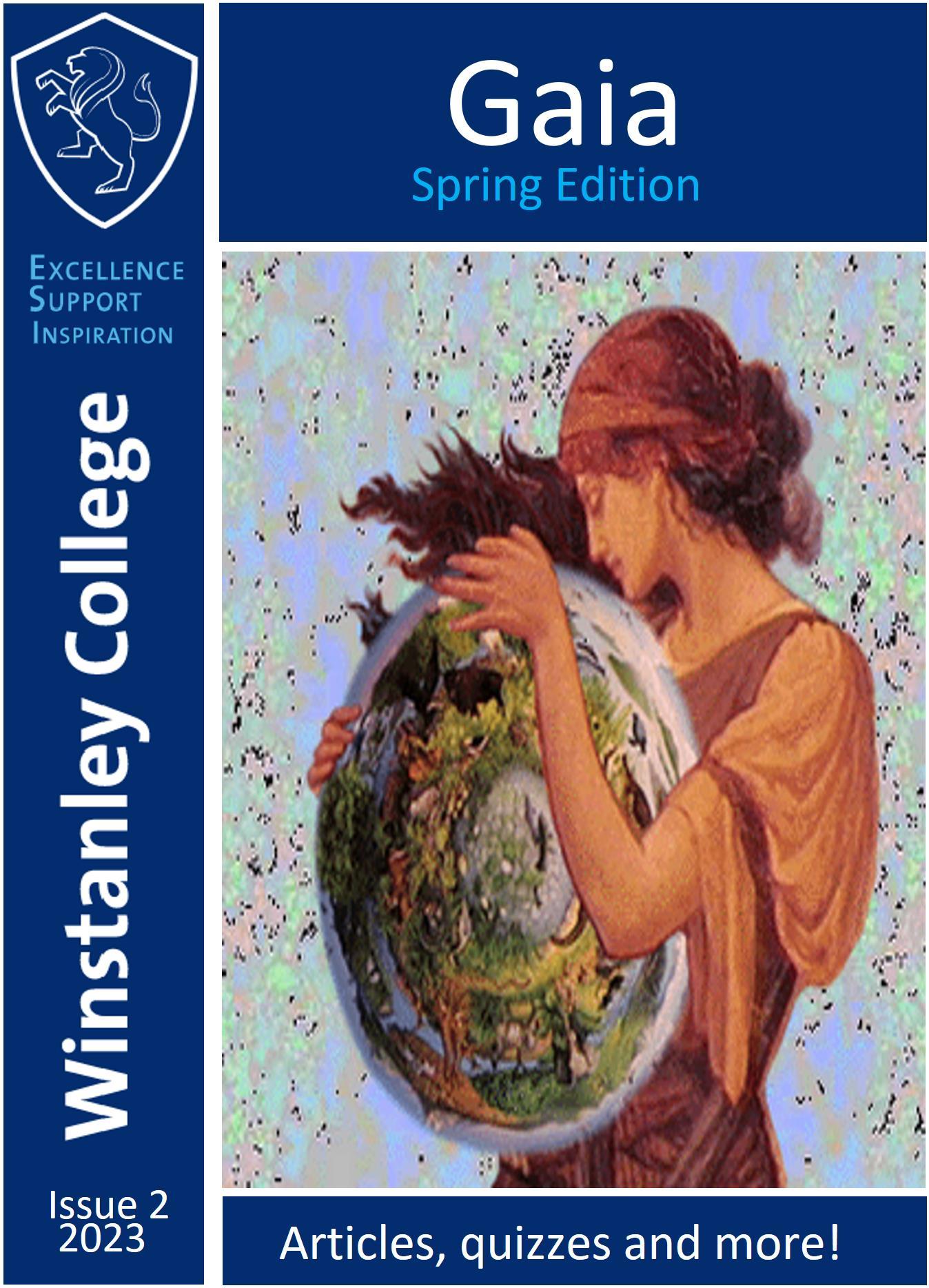
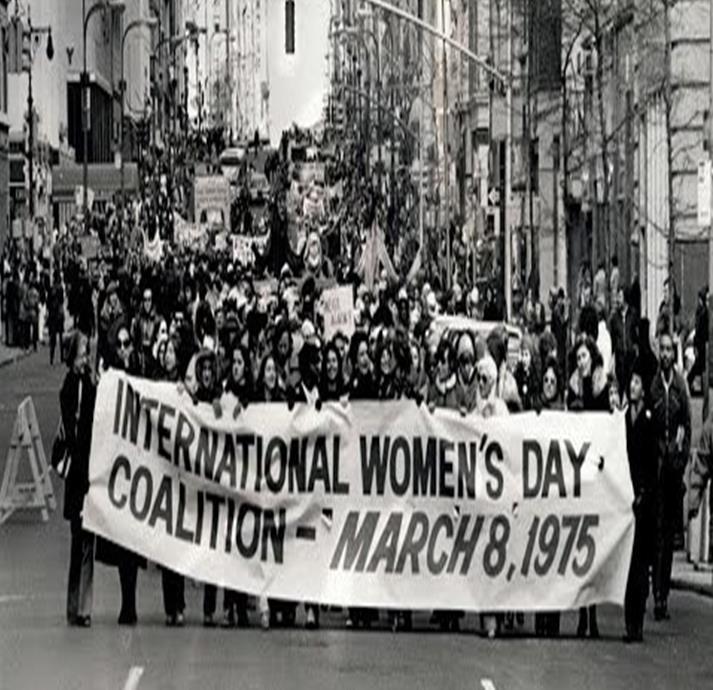
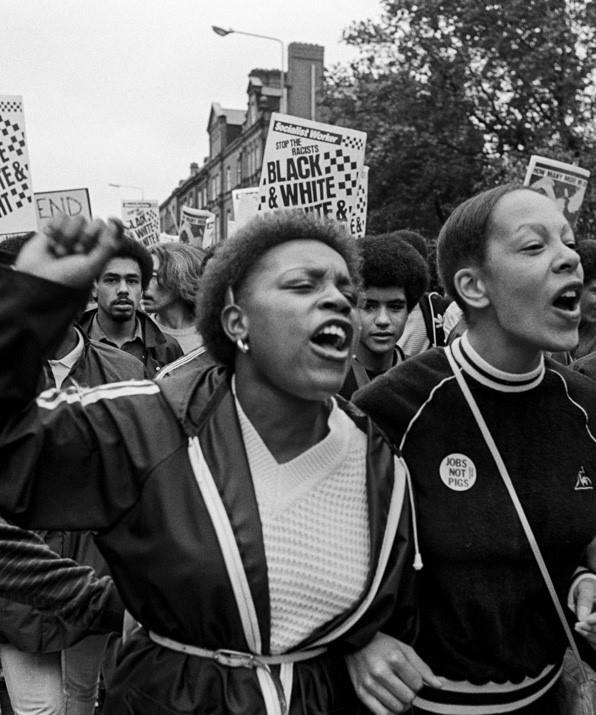
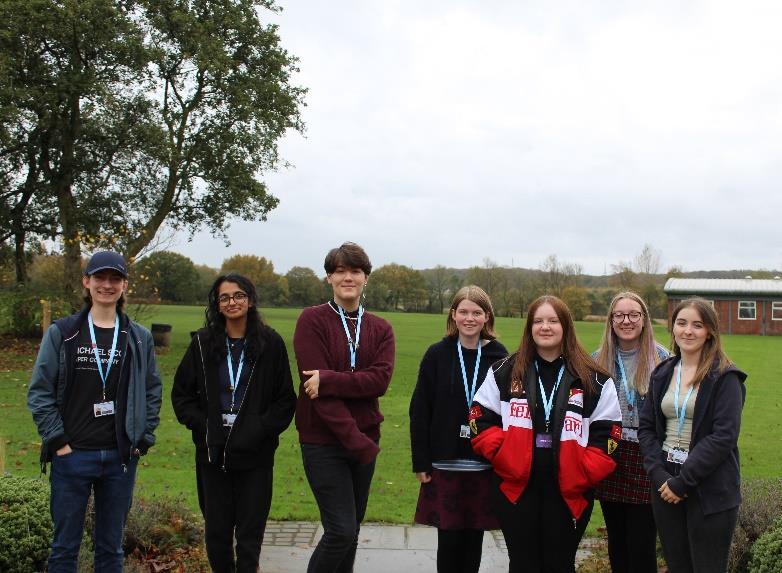
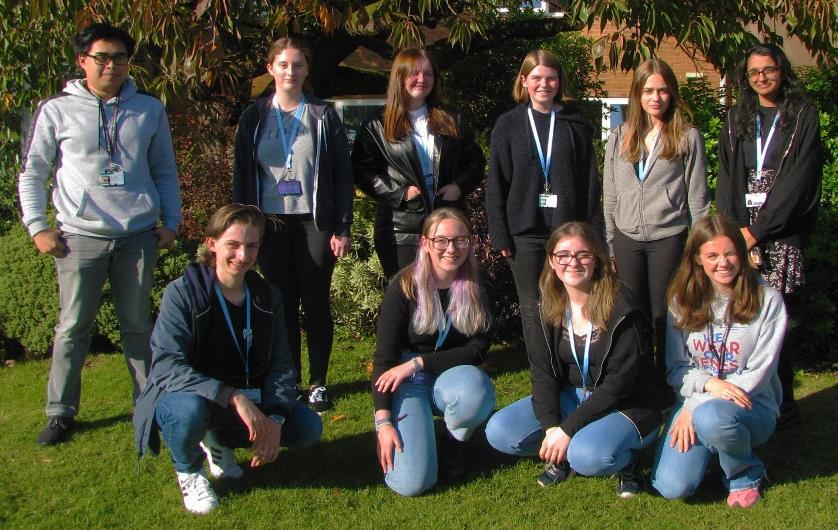


















 the last half-term, both students and teachers have been busy hosting informative talks on many different topics surrounding History, Geography and Geology. Above is just two examples, but there have been many more We have also hosted events such as the historical speed dating and the "Classics and Ancient History” lecture.
the last half-term, both students and teachers have been busy hosting informative talks on many different topics surrounding History, Geography and Geology. Above is just two examples, but there have been many more We have also hosted events such as the historical speed dating and the "Classics and Ancient History” lecture.








 By Amy Moss
By Amy Moss



 By Charlotte Fern
By Charlotte Fern
 Aragon, Anne Boleyn, Jane Seymour, Anne of Cleves, Katherine Howard and Catherine Parr
Aragon, Anne Boleyn, Jane Seymour, Anne of Cleves, Katherine Howard and Catherine Parr
 By Anna McGlen
By Anna McGlen

 By Alyssa Price
By Alyssa Price











































































